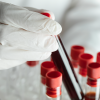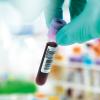The story of a US blood test that it was claimed would lead to a healthcare revolution, but ended in a multi-million dollar scheme to defraud investors.
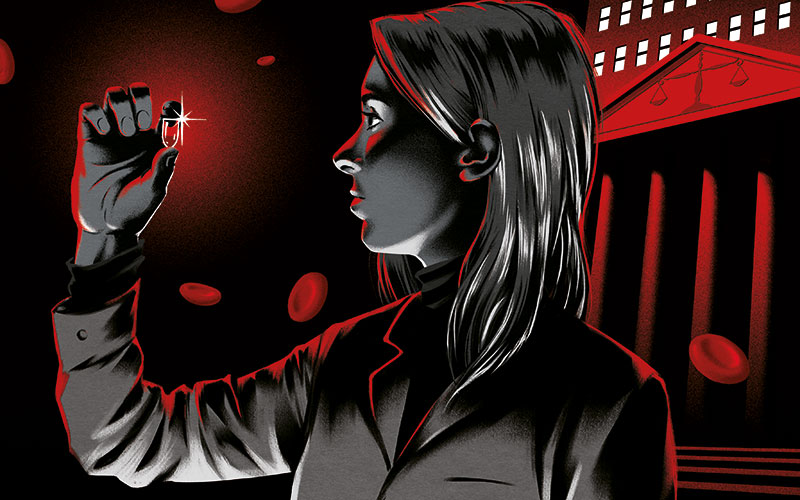
It sounded too good to be true. A blood test that could detect the markers for dozens of different health conditions from the merest pinprick of fluid taken from the tip of a finger. No need for big needles stuck in the arm, no need for multiple samples and no need to wait days for the results, which could be processed accurately in a matter of hours by a single bespoke device.
Of course, it was too good to be true. The science underpinning these claims was lacking. But it took more than a decade to uncover the truth about Theranos, the company fronted by Elizabeth Holmes, by which time investors had lost hundreds of millions of dollars and the many patients who had put their faith in the test results had been told they were in fact worthless. After a high-profile trial in San Francisco, Holmes has been found guilty on four counts of fraud and now faces a long prison sentence.
Revolutionise healthcare delivery
The rise of Theranos began in 2003 when the 19-year-old Holmes, then studying at the School of Engineering at Stanford University, spent her internship at the Genome Institute of Singapore working with SARS test samples. This experience seeded the idea to develop a test that could find the evidence of a range of health issues using just a single drop of blood and mucus. At the same time, Holmes began working on a patent for a skin patch that would apply and adjust doses of medication, such as antibiotics.
Believing she was on to something with the potential to revolutionise the delivery of healthcare, Holmes attempted to enlist the support of Stanford academic luminaries. A few bluntly told her it would not work. Among them was Phyllis Gardner, a professor of medicine, who felt Holmes’ ideas betrayed a fundamental lack of understanding about how blood samples and antibiotics worked.
Undeterred, but with the vital backing of the dean of Stanford’s School of Engineering, Holmes dropped out of the following year in order to set up a medical technology company and pursue her vision. The name she settled on was Theranos – a composite of “therapy” and “diagnosis”.
She quickly secured her first $1m of seed investment from a family friend who happened to be a venture capitalist. She rented a lab, she took on employees, and she continued to pitch the idea of a technological breakthrough. By the time 2006 rolled round, she had close to $30m.
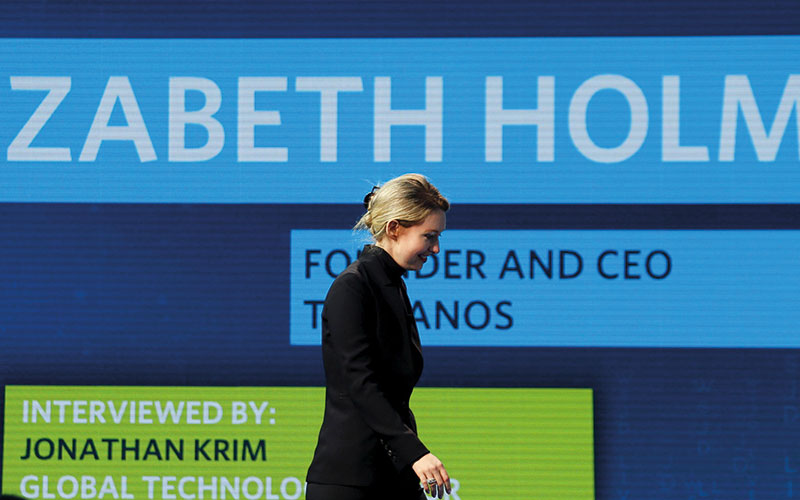
Hype and hustle
During these early years, Holmes and Theranos operated in stealth mode – no company website, no press releases, no figures, no nothing. While this was not unusual for a Silicon Valley tech start-up, it was not normal for the healthcare sector, where solid data tends to translate as solid gold. But the story of Theranos and how it managed to attract so much investment based on so little evidence cannot be told without some reference to Holmes’ character and style.
She played the largely male Silicon Valley game of hype and hustle by taking on the guise of a female Steve Jobs – she adopted the Apple founder’s trademark black roll-neck jumpers, his presentation style and his direct manner, along with her intent gaze and striking baritone voice. Whether all this was entirely natural, as she claimed, or a carefully crafted persona, it certainly caught the attention of investors and other backers, including political heavyweights, including Henry Kissinger, George Schultz and James Mattis, big family investment concerns, such as Bechtel, DeVos and Walton, and even the normally wily Rupert Murdoch.
At its peak in 2014, Theranos had attracted $400m worth of investment and was valued at a staggering $9bn, though it remained hard to see exactly what it had done to attract such a valuation. Beyond the sheen of self-promotion, the company’s fortunes rested on the proprietary devices it said it was developing to deliver the all-important tests.
“She played the Silicon Valley game of hype and hustle by taking on the guise of a female Steve Jobs”
The key tasks for these tools were to automate the analysis of the tiny sample sizes. The first was called the “nanotainer”, which, as its name suggests, was a small container barely the size of a pill that was used to collect no more than couple of drops of blood taken from the patient’s finger. This sample, held in its nanotainer, would then be transferred to a Theranos lab and the analysis machine itself, which Holmes christened the “Edison”. The idea was that the Edison would take instructions over the internet from doctors and patients on what tests to run, communicate the results, and then retest or specify follow-up tests.
Bargain-price revolution
While Theranos still refused to share any data or specifics of the technology, it would sooner or later have to provide some real-world evidence that its devices did indeed work. It took its first steps towards doing this in 2013 with an agreement with Walgreens, the operator of the second largest pharmacy chain in the US, to host blood sample collection services in its stores in Phoenix, Arizona. This process would involve no clinics, no appointments and seemingly no more hassle than going to the local chemist to print off a few digital photos. If successful, it would be rolled out nationwide to some 8,000 stores.
To give users a helping hand, Theranos published a menu of tests that they could order, along with the pricing. It started with a urinalysis at $1.55 then cycled through more than 250 other entries until finishing with a hepatitis C virus genotype test at $117.96. In between you could choose to test your cholesterol ($2.99), uric acid levels ($3.11), insulin levels ($7.86), for any traces of cocaine, ecstasy, marijuana ($10), vitamin B-12 ($10.36), various cancer antigens ($14.31), HIV ($16.56) and tuberculosis ($42.60).
The healthcare revolution had begun – and at great prices.
But stubbornly resisting the revolution was the science. As Phyllis Gardner had warned 10 years earlier, blood samples simply don’t work like that. For a start, any blood taken from the fingertip is likely to contain as much tissue fluid as blood, and the levels of vital molecules, such as proteins, are bound to be compromised.
In fact, the only way to guarantee good, uniform levels of molecules that can give a clear picture of what’s happening is by taking the blood in the tried and tested manner – from a vein.
Tony Cambridge, Lead Biomedical scientist at University Hospitals Plymouth NHS Trust, argues that the pinprick approach was simply not feasible: “The challenge of producing accurate and reproducible results for so many tests from such a low volume of blood was always too great. Any lab scientist will know that reducing sample size is usually accompanied by a loss in sensitivity.”
Just as ominous for Theranos, and impossible to separate from the issue of the blood samples themselves, was its seeming inability to get the Edison machine to work. The problem here for outside observers was that nobody beyond a handful of insiders had any idea what the technology was. Any number of existing small devices in a lab can conduct multiple blood tests, but they had all gone down the route of being properly evaluated and verified. Holmes and the company persisted in maintaining a high wall of secrecy around the Edison and any data available for peer review was conspicuously absent.
Elizabeth Holmes factfile
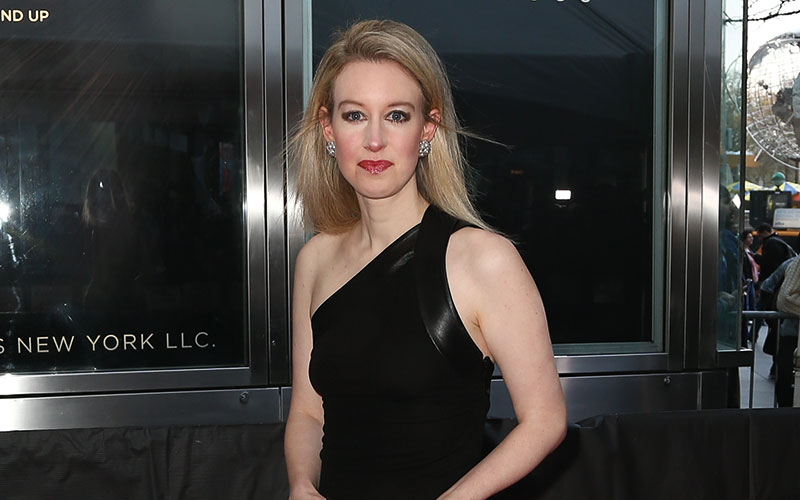
- Born on 3 February 1984 in Washington DC
- Her father, Christian Rasmus Holmes IV, was a vice president at Enron (an energy company that later went bankrupt after an accounting fraud scandal)
- Her mother, Noel Anne, worked as a Congressional committee staffer
- Before the collapse of Theranos, Holmes received widespread acclaim
- In 2015, she was appointed a member of the Harvard Medical School Board of Fellows and named one of Time magazine’s “Time 100 most influential people”
- Holmes was ranked number 73 in Forbes 2015 list of “the world’s most powerful women”
- A year later Fortune named Holmes in its article on “The World’s 19 Most Disappointing Leaders”.
Media attention
The wider science community looked on with increasing suspicion. In February 2015 Professor John Ioannidis, again from Stanford, published a short piece in The Journal of the American Medical Association (JAMA) entitled “Stealth Research: Is Biomedical Innovation Happening Outside the Peer-Reviewed Literature”.
If ever a question was loaded to prompt an answer of an emphatic “no”, it was this one. Ioannadis says Theranos offered him the opportunity to work on a new paper with Holmes if he recanted the JAMA article – he declined.
Then in May 2015, Dr Eleftherios Diamandis at the Mount Sinai Hospital in Toronto published a piece called “Theranos phenomenon: promises and fallacies” in Clinical Chemistry and Laboratory Medicine. Diamandis had been prompted to investigate by hospital bosses, who were wondering just how Theranos was able to provide tests at a tenth of their usual cost. Having surveyed the available evidence, he concluded that the company’s “claims of superiority over current systems and practices are speculative, at best”.
Theranos’ edifice of secrecy would face an even sterner test as it began to draw more media attention. With a young and striking innovator at the helm of company worth billions, the press was suddenly all over Holmes, likening her to Elon Musk and Jeff Bezos. Forbes, Fortune and The New Yorker all ran lavish profiles. Though it had held off much scientific scrutiny, Theranos was about to find that examination under the media lens was much harder to evade.
One journalist paying close attention was John Carreyrou of The Wall Street Journal. Through a chain of contacts who were growing increasingly sceptical of the Holmes’ bandwagon, Carreyrou found himself talking to a former Theranos lab worker, who had joined the company after graduating from Stanford in 2013 but quit in acrimony just eight months later in April 2014.
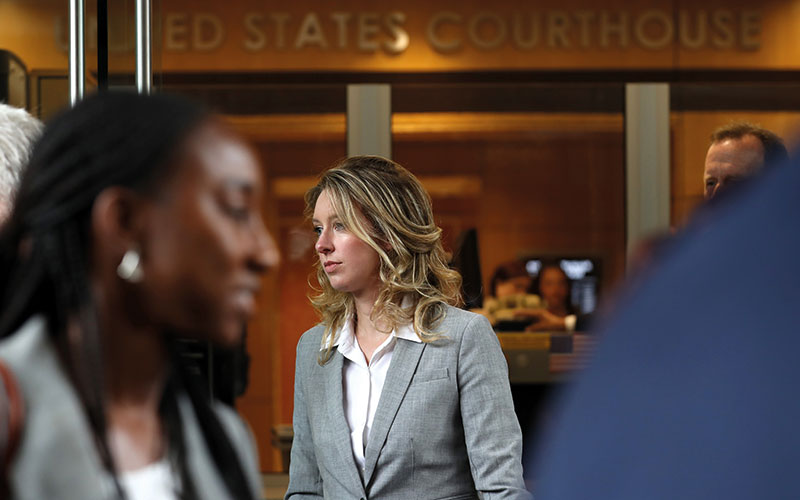
“Remember to believe the science and the data, not the sales pitch or concept”
The whistleblower told Carreyrou that he had left the company after he had discovered unethical behaviour and on raising the issue directly with Holmes had been hit with an aggressive response from her partner and Theranos president Sunny Balwani. The former employee’s concerns had centred around the troubled Edison devices – he claimed that not only were the machines failing Theranos’ own quality control tests (the benchmark for accuracy results was 95%, the Edison was hitting just 65%), the company was also doctoring the wildly varying results to make them look better. The ongoing struggles to get the Edison to work also meant the lab had to bring in validated third-party devices to process the actual blood tests.
Carreyrou’s article appeared in October 2015. Holmes tried to shut down the piece down by appealing directly to Rupert Murdoch, Theranos investor and owner of The Wall Street Journal, but was rebuffed. In another twist, it transpired that Carreyrou’s whistleblower was Tyler Schultz, grandson of George Schultz who was on the Theranos board of directors.
The downfall
From this point, having spent more than a decade building the promise of a new era of healthcare that would be cheaper and more accessible, all the while struggling to develop the tech that would fulfil that promise, the downfall of Holmes and Theranos was swift.
The Food and Drug Administration (FDA) inspections found that Theranos’ quality management systems were severely lacking and that the nanotainer, which had gone unregulated via a legal loophole, was “not validated under actual or simulated use conditions”. From a UK perspective it appears odd that the regulators took so long to intervene in any meaningful way, especially as the system of regulation here, including the requirements for registered scientists, along with the demands of the UKAS and EQA structures, would never have allowed the situation to develop as it did.
Finally, in the wake of the FDA findings, the company suspended its test and Holmes announced she would finally publish data, but it was all too little too late (and still the data failed to materialise).
Throughout 2016, Federal and state medical authorities circled. Investigations, sanctions and suspensions followed. The company’s lab in Newark, California was condemned as posing “immediate jeopardy to patient safety”.
In June 2016, Walgreens terminated its partnership with Theranos and in October the embattled company laid off hundreds of staff. In January 2017 the lab in Scottsdale, Arizona also failed an inspection and was closed. The company fired hundreds more employees and found itself fending off bankruptcy and lawsuits from Walgreens and the Arizona Attorney General.
Worse was to follow in 2018 – criminal proceedings. The US Department of Justice accused Holmes and Balwani of engaging “in a multi-million dollar scheme to defraud investors, and a separate scheme to defraud doctors and patients” and charged them with two counts of conspiracy to commit fraud and nine counts of fraud.
Just a few months later Theranos was wound up and its high-profile investors were writing off their losses. Amid the wreckage were thousands of unsuspecting patients who had put their trust and blood samples in the hands of Theranos and now had to pick their way through the rubble of potential false negatives, false positives and interventions based on inaccurate results.
Importance of rigour
“Their business model was built around an unproven concept where they were trying to create the technology as they went,” says Tony Cambridge. “Remember to believe the science and the data, not the sales pitch or concept.”
For the biomedical science community, time will tell if the Theranos saga has left investors, regulators and the public wary of legitimate diagnostic breakthroughs. The upside is that it has reaffirmed the vital importance of a rigorous scientific method. “Science is about setting a hypothesis and having it challenged by peer review,” says Dr David Ricketts at Health Services Laboratories. “Getting this right makes much better sense, which is a lesson learnt from recent events.”
Where Theranos failed, diagnostic innovations with firmer scientific foundations are still making progress. The NHS-Galleri trail, for example, began last September collecting blood samples from 140,000 volunteers at mobile testing clinics across England. This test works by finding chemical changes in fragments of genetic code – cell-free DNA (cfDNA) that leak from tumours into the bloodstream – it can detect more than 50 types of cancer before symptoms appear. NHS chief executive Amanda Pritchard says: “The test is particularly effective at finding cancers that are typically difficult to identify early. This could mark the beginning of a revolution in cancer detection and treatment.”
Timeline
2003 Holmes drops out of university and launches what will become Theranos Inc
2007 Theranos is valued at an estimated $197m
2010 Another fundraising round boosts Theranos’s valuation above $1bn
2013 Theranos begins offering blood tests to the public in Arizona and California
2014 Theranos’s valuation rises to $9bn
2015 The Wall Street Journal publishes its first article exposing shortcomings with Theranos’s technology
2016 Theranos closes its medical lab operations amid regulatory scrutiny
2018 Criminal fraud charges are brought against Holmes and Balwani
Jan 2022 Holmes is convicted on three counts of fraud and one count of conspiring to defraud private investors in the company
Mar 2022 The trial of Balwani is scheduled to begin on 9 March
Sep 2022 Holmes is due to be sentenced on 26 September.
Image credit | InsideDPS |Alamy| Shutterstock |Getty


